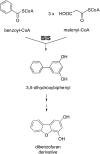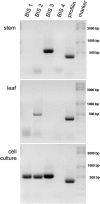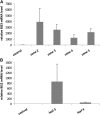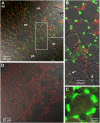Differential expression of biphenyl synthase gene family members in fire-blight-infected apple 'Holsteiner Cox'
- PMID: 22158676
- PMCID: PMC3271774
- DOI: 10.1104/pp.111.190918
Differential expression of biphenyl synthase gene family members in fire-blight-infected apple 'Holsteiner Cox'
Abstract
Fire blight, caused by the bacterium Erwinia amylovora, is a devastating disease of apple (Malus × domestica). The phytoalexins of apple are biphenyls and dibenzofurans, whose carbon skeleton is formed by biphenyl synthase (BIS), a type III polyketide synthase. In the recently published genome sequence of apple 'Golden Delicious', nine BIS genes and four BIS gene fragments were detected. The nine genes fall into four subfamilies, referred to as MdBIS1 to MdBIS4. In a phylogenetic tree, the BIS amino acid sequences from apple and Sorbus aucuparia formed an individual cluster within the clade of the functionally diverse type III polyketide synthases. cDNAs encoding MdBIS1 to MdBIS4 were cloned from fire-blight-infected shoots of apple 'Holsteiner Cox,' heterologously expressed in Escherichia coli, and functionally analyzed. Benzoyl-coenzyme A and salicoyl-coenzyme A were the preferred starter substrates. In response to inoculation with E. amylovora, the BIS3 gene was expressed in stems of cv Holsteiner Cox, with highest transcript levels in the transition zone between necrotic and healthy tissues. The transition zone was the accumulation site of biphenyl and dibenzofuran phytoalexins. Leaves contained transcripts for BIS2 but failed to form immunodetectable amounts of BIS protein. In cell cultures of apple 'Cox Orange,' expression of the BIS1 to BIS3 genes was observed after the addition of an autoclaved E. amylovora suspension. Using immunofluorescence localization under a confocal laser-scanning microscope, the BIS3 protein in the transition zone of stems was detected in the parenchyma of the bark. Dot-shaped immunofluorescence was confined to the junctions between neighboring cortical parenchyma cells.
Figures









References
-
- Beerhues L, Liu B. (2009) Biosynthesis of biphenyls and benzophenones—evolution of benzoic acid-specific type III polyketide synthases in plants. Phytochemistry 70: 1719–1727 - PubMed
-
- Billing E. (2011) Fire blight: why do views on host invasion by Erwinia amylovora differ? Plant Pathol 60: 178–189
-
- Bradford MM. (1976) A rapid and sensitive method for the quantitation of microgram quantities of protein utilizing the principle of protein-dye binding. Anal Biochem 72: 248–254 - PubMed
Publication types
MeSH terms
Substances
Associated data
- Actions
- Actions
- Actions
- Actions
LinkOut - more resources
Full Text Sources
Miscellaneous

